Smithology: Are you not amused? You could be

You are probably watching the wrong sport.
This has nothing to do with stick-and-ball games. And really, it’s not that the sports you like are bad, per se.
It’s just that they’re not MotoGP.
At the risk of sounding like Yogi Berra, the people who know this don’t need to be told. Statistically speaking, those individuals are probably not on this website anyway. They are almost certainly lingering, right now, on some motorcycle-enthusiast forum or subreddit or some all-knowing house of riding gear, like Revzilla. A niche spot, in other words, because MotoGP is motorcycle racing, and bike racing in any form is niche entertainment in this country.
Niche meaning, of course, that most people either think it’s dumb or simply don’t care.
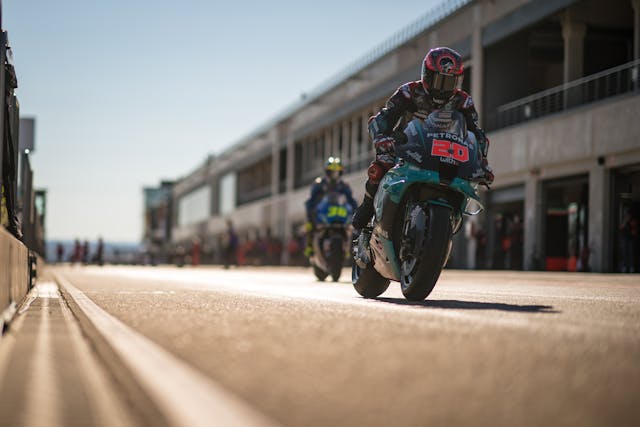
“But Sam,” you say. “I do not like motorcycles. Zero interest! My brother’s sister’s husband’s hamster’s daughter has a Harley Sportsbagger or something, and it sounds like a potato gun, and I also had a good friend who died a little once on a 2000-horse Gixxer at the tender age of 7 because they sold it to him without training and he didn’t wear a helmet or nuthin’ but that’s not his fault. Bikes are bad.”
“Hold on,” I say. “This is not about motorcycles.”
I mean, it is. But it’s also not. Mostly not.
Sort of.
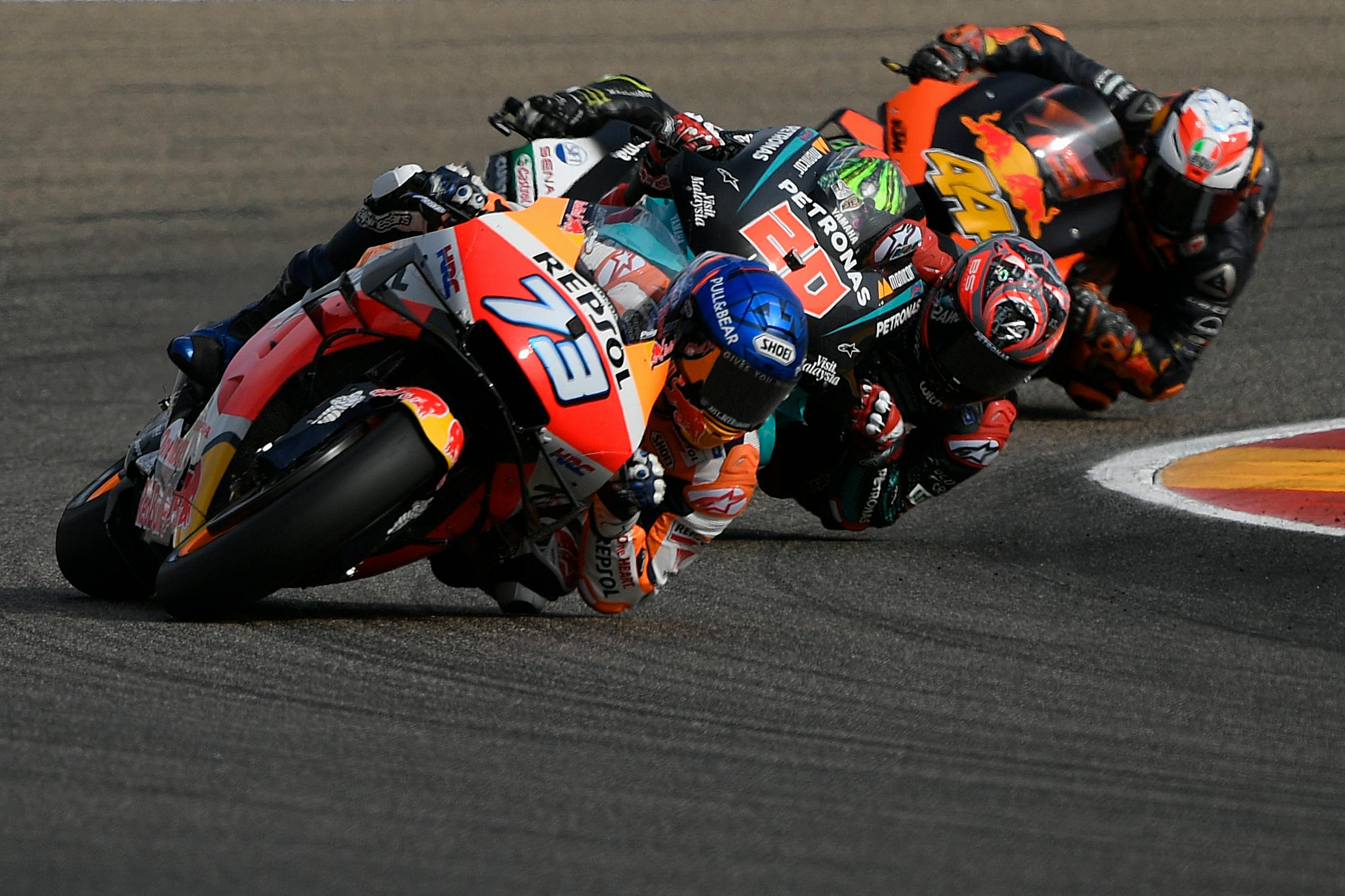
Before we go any further, consider three vital pieces of information:
- Humans generally enjoy the violent ballet of a machine allowed to run visibly ape.
- You do not have to love motorcycles to love watching them go ape.
- We need gladiators.
To truly understand the glory of MotoGP, you have to know at least a little about the problems with the rest of the racing world. The current pantheon of globally popular motorsport is as follows, in rising order of popularity:
SPORTS-CAR RACING: Neat and expensive machinery, mostly derived from road cars, driven by wealthy amateurs and a small cadre of talented professionals. Occasionally exciting but too dictated by the past and rulebook insanity. Generally governed by what the wealth wants. Watched mostly by die-hards. Sports cars once drew huge crowds, but then the sanctioning bodies seemingly stopped caring about what ordinary people like to watch.
INDYCAR: Expensive spec machinery, extreme in capability and purpose-built. Generally populated by hyperfit drivers who can wrestle a physically abusive vehicle out of a slide at 200 mph, though aerodynamics and modern race tires often mean that slide is too subtle to be seen from the stands. Respectably large but dwindling audience. Most people know the sport only through the Indy 500, a century-old event with a strange dual identity as both the country’s greatest motor-racing challenge and a solid reason for many people to get blurtmouth drunk on a Sunday in May before falling asleep an hour in.
NASCAR: V-8-powered, tube-frame brickbats that lightly resemble modern road cars but have more in common with a ’60s pickup. Large but shrinking audience. The cars contain instances of remarkably high technology and take real work to drive—more 200-mph slides here—but spectators are rarely close enough to see that work, and TV cameras dull the action.
WORLD RALLY CHAMPIONSHIP (WRC): Neat and expensive machinery, generally derived from road cars and competing almost entirely on public roads. Flat-out over dirt, snow, and pavement, in all weather. WRC showcases some of the world’s greatest drivers, the cars perpetually and visibly on edge. It is dramatic, but hard to watch in America, because the broadcasts usually … aren’t in America.
FORMULA 1: The single most expensive motorized sport on earth, and the arguable peak of four-wheeled racing. The cars are one-offs built from scratch to NASA standards. Outside the United States, the audience is massive. Competition is governed by outlandish budgets and aerodynamic downforce; races are thus often boring processionals, dictated by team spend and airflow. The sport houses some of the world’s most talented drivers, plus some of the world’s wealthiest rich kids, buying seats. (A recent Netflix documentary series logged a valiant effort to repackage F1 for American audiences, but it mostly just illustrated how the politics here are way more interesting than the actual racing.)
***
I love each of these sports a great deal, but I’m 39 years old and an exception. I’ve been an active club racer for almost two decades, and I have chased spectator motorsport since elementary school. The knowledge and momentum of that background helps—without it, most forms of top-flight racing can be difficult to parse or even care about. If you’re not buried in the minutiae of rulesets and microscopic engineering gain, this world can seem rote, short on authentic joy, on clearly sparkling talent, on the taming of animal machinery.
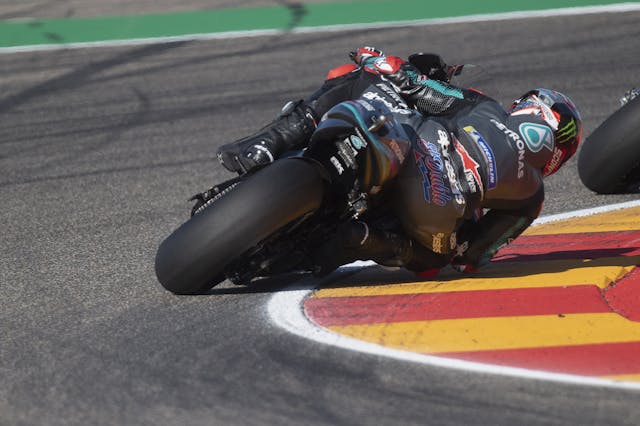
Except here.
Humans want gladiators. We get something pure and deeply inspirational from watching the best of us accomplish seemingly impossible feats in a manner patently obvious to an ordinary person. In the best of these situations, there is risk from which any ordinary person would run screaming. Plus noise, spectacle, insane skill that makes you fall off your chair and yell at the screen.
Love of motorcycles is nearly irrelevant with motorcycle racing; you can love the Kentucky Derby without caring about horses. And really, cars are an excellent lens into the framework. At its core, a bike is a car minus frippery—an engine, wheels, a body in motion atop a seat.
Consider this pared-down machine flogged to the hilt in an environment where live humans hang their bones in the breeze well in excess of 100 mph. Where those people fight every second to stay in millimeter control of body mass and machine while undergoing battery not an ounce short of physical abuse.

Now go a step further: Imagine those people willingly exposing themselves to obvious risk in exchange for the chance to be the best in the world at an extraordinary task, making choices we can’t or won’t. Imagine even the best of those people, literal world-beating talent, in the fastest form of motorcycle racing on the planet, coming apart due to strain or loss or the phase of the moon.
A near-dominant world champion in the prime of his career repeatedly tells press that he must fall off the bike in order to learn. Then he crashes in the first race of the season while chasing his seventh consecutive title, breaking his humerus on the front wheel and losing both the year and the record books. A talented 25-year-old Spaniard saves his own life when his brakes fail by making the split-second decision to jump off a bike at 135 mph, tucking and rolling through race traffic; he chooses pavement impact over an uncontrolled ride into a wall. A young wunderkind nudges his riding style forward in response to ever-changing tires and competition; hung off the bike in a corner, the pavement touches a knee, occasionally an elbow, and then, remarkably, almost impossibly, his shoulder. (He wasn’t the first to do it, but still, the crowds love the shoulder.)
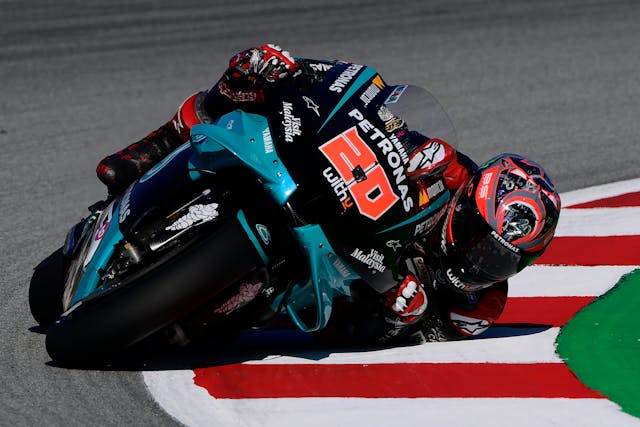
The bikes are alien and perpetually evolving, built by multiple manufacturers. They perform noticeably different from maker to maker—Ducati, KTM, Honda, Yamaha, Aprilia. Some have better rip off a corner, some just seem to bat into a pivot under braking, some can’t do anything right. In that last case, you often see a rider’s frustration in bold neon, watch from an on-bike camera as his body struggles to force the machine into the corner, almost feel the dance go wrong through the screen. Men are inches from each other’s arms and feet in corners, no rear-view mirrors, stalking and out-thinking while playing 150-mph chess.
This is MotoGP in 2019 and 2020. Who would say no to any of that?

About that shoulder. It is a hint at the process, how a rider must move. I have a small amount of track experience on a motorcycle and cannot claim to be good at it, but the glimpse of that world was sunlight through the clouds. The physical work required of a professional on the clock is intoxicating, the bodily resolution unearthly. A motorcycle only turns if you move above and around and seemingly through it, using your form to nudge its steering geometry and center of mass. The art of racing a motorcycle is thus the art of constantly puppeting your body over the frame while simultaneously measuring control inputs by the angstrom. In MotoGP, as in most professional motorsport, the ability to lap a two-mile circuit at a consistency of tenths or hundredths of a second is nothing exceptional, merely a requirement for entry.
Race cars, of course, require many of the same ideas regarding weight transfer. But the human there is hidden away, the results dulled under a blanket of mass and progress. We have not been able to witness race cars and their drivers this visibly engaged—sliding, fighting, arms in the breeze—since a moon landing was news.
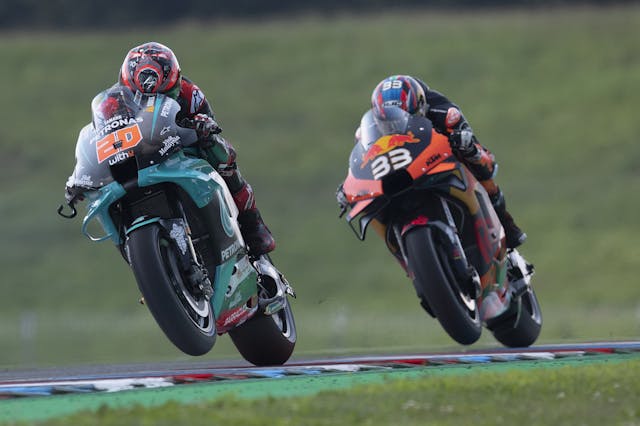
A sampling of detail: The bikes are like F1 cars in miniature, every component arted up from scratch, lightweighted obsessively, and aimed at a singular goal. MotoGP engine manufacturers have problems not of power but of power delivery, so the bikes have evolved to keep their front wheels on the ground. This means firing orders and crankshaft geometries aimed at progressive power, not all-out thrust. (Power is easy; usable power is hard.) And somewhere in the middle of all this lies the fact that the sport regularly seems to surprise itself—a middle-aged genius competes heads-up with young guns for a championship, say, or a backmarking manufacturer comes back from the proverbial dead, or a funny, grinning Kentuckian rises from an unlikely dirt-track background in Owensboro to riding-crop a Honda to a world championship and the top of a life.
I always liked that kid from Kentucky. Maybe because I grew up there. We’re drawn to the familiar, especially in the midst of the unfamiliar.
Four decades ago, American racing legend and former Formula 1 driver Dan Gurney co-authored a white paper laying out what he saw as the problems of American motorsport. Gurney suggested a handful of changes to IndyCar racing in particular, noting that the cart of that business had begun to pull the horse. The product—the show—was suffering, he said, not focused enough on fans or drivers. People would leave, he suggested, though it might take a while. Possibly years.
For better or worse, Gurney’s suggestions were not widely adopted. I think on them from time to time, whenever I find myself drooling with boredom in front of some televised race, wondering why the car world can’t pull its head from its pipe. Then I fire up a screen and go watch a bunch of motorcycles sling into the distance and forget all of it.

